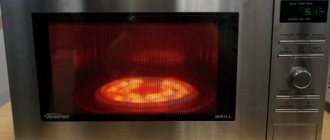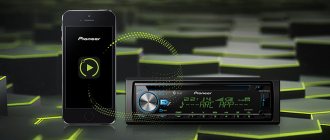Who invented the household microwave oven?
There are two versions of creating an electrical appliance. According to the first, the history of the microwave began during World War II: the technique was invented in Germany for the German military. Later, the drawings of the German microwave came to other countries, including the USSR.
According to the second version, the invention of the microwave oven belongs to the US scientist and engineer Percy LeBaron Spencer.
During one of his experiments, Spencer noticed the effect of magnetic waves on a candy lying in his pocket. After this, the scientist tried to perform a similar experiment, only with popcorn. The result was similar.
After conducting a series of experiments, Spencer registered his first patent on October 8, 1945. Two years later, microwaves went into production, but they were used only by the military to quickly defrost food.
Biography of Percy LeBaron Spencer
The future inventor was born in Maine on July 9, 1894. When Spencer was three years old, his father died and the boy was sent to be raised by his aunt.
At the age of 12, Spencer began working in a spinning mill, without even receiving a secondary education.
Percy Spencer in his youth
In 1925, Percy got a job at the newly emerging company Radarange, which was developing equipment for radars.
In 1945, he made the greatest discovery of his life - heating food under microwave radiation.
Who invented the microwave
There is no agreement on this issue to this day. Russia and the United States dispute the authorship of the microwave oven, however, the patent belongs to the inventor from the United States.
Historians' versions of who invented the microwave oven
One of the most plausible versions sounds like this: the American engineer and inventor Percy LeBaron Spencer once, during experimental work with a magnetron, discovered that a chocolate bar in his pocket had melted during the work. There is also a version that he placed a sandwich on a magnetron, and then discovered the heating of food while the device was operating. It is likely that during the experiments he received a burn, but when he received a patent for the invention of a microwave oven, he decided to keep silent about it so as not to spoil the image of his brainchild.
Another version, set forth in the Trud newspaper on May 17, 2011, states that back on June 13, 1941, on the pages of the same newspaper, a device was described that used ultra-high-frequency currents to process meat products. The development was allegedly carried out in the magnetic wave laboratory of the All-Union Research Institute of the Meat Industry.
There are also versions about German developments during the Third Reich that fell into the hands of scientists from the USSR and the USA. But they never received confirmation.
Patent for the invention of a microwave oven
A patent for a prototype microwave oven was issued in 1946. It was called “Radarange”, its first release dates back to 1947, and was used to quickly defrost food products. It was used only by military personnel in canteens and hospitals.
Interesting to know!
The first microwave was about 180 cm in height and weighed about 340 kg. The power consumption was twice that of modern analogues and consumed 3 kW, its cost was quite high - 3 thousand dollars.
The world's first microwave ovens
The first electrical devices from this series came into use only in 1947, but only the military had them. The first samples belong to the Radarange company.
The first microwave ovens from Radarange
The dimensions of the devices were impressive: about 1.8 meters wide and about two meters high. The mass of the first microwave ovens was approximately 300 kilograms, so several people were required to move the electrical appliance.
Most samples had a transparent window that allowed you to monitor the melting of food. To cool this giant, ordinary water was used, and it required a lot of electricity to operate. As a result, the cost was very high - each device cost about three thousand dollars.
Scientists' disputes
After Spencer created the device, the scientists split into two groups. Some believed that the device was safe and people could use it without fear of health. Others argued that the electrical appliance could lead to the development of dangerous diseases such as cancer.
At the same time, no contraindications have been reported from the inventors of the stove. Opponents of microwave ovens argued that baby food and milk should not be heated in an oven due to the negative effects of microwave waves.
In addition, when water molecules are passed through microwaves, some of the radiation remains in the food. This can contribute to a decrease in hemoglobin in the blood and an increase in cholesterol.
Myths about the microwave oven
From the origins of microwave ovens to this day, there has been a lot of misinformation about the devices. Here are the most common:
- The molecular structure of foods after microwave ovens changes and they become dangerous. In fact, the movement of water molecules accelerates, and the food heats up as a result. All that can happen to food is local overheating, which will lead to burning or a decrease in nutrients in the food.
- Microwaved food may taste different, but no changes in molecular composition occur. The device simply heats the food equally on all sides, because of this the moisture is distributed evenly, unlike an oven or frying pan.
- The quality of heating in microwave ovens does not depend on the price of the device. This is evidenced by a number of experiments conducted with devices of different price categories. When purchasing an expensive microwave oven, the user pays for build quality, brand, and safety. After all, many unknown companies undergo incomplete testing or do not test their products at all.
- The microwave oven emits harmful rays. It is not true. As long as a safe distance of one and a half meters is maintained, a person is not in danger.
Distribution of microwave ovens
Despite the suspicions and fears of scientists, the equipment successfully gained sales momentum, because it was a convenient and practical thing in everyday life. The inventor himself had no doubt about the success of his product, as he considered it irreplaceable. Let's look at the stages of microwave development:
- The very first household microwaves were enormous in size. Initially, they were used only by the military, but by 1949 mass production began, and electrical appliances appeared in rich homes. The cost of the device was three thousand dollars.
- Microwave ovens were improving and by 1962 they were becoming much more affordable. The price for one device has decreased several times.
- In 1966, the rotating rack was invented to distribute the outgoing microwaves evenly onto the dish.
- By 1979, the electrical consumption of microwave ovens was reduced due to the installation of a microprocessor. Another useful feature is added - automatic shutdown.
Microwave ovens equipped with a microprocessor - Control of electrical appliances became even more simplified with the introduction of the microcomputer in 1999. At this time, functions also appeared that made it possible not only to heat up ready-made food, but also to cook it. This was facilitated by the “Grill” and “Convection” functions.
Market Capture
Despite all the fears and publications, microwave ovens were actively produced and sold. The American inventor had no doubt about the effectiveness of his product, despite the indignation and criticism of scientists.
Here are a few stages that furnaces have gone through from their inception to the present day:
- The first ovens were incredibly bulky and reached a height of about 1.8 meters. The devices weighed approximately 1.5 tons, which did not allow the device to be moved without assistance. Their cost was approximately $1,000, which indicated that only very wealthy citizens could afford a microwave.
- The stoves went on sale in 1962.
- In 1966, the stoves began to be equipped with the usual rotating stand.
- By 1979, the furnace was already controlled by a microprocessor.
- And in 1999, control began to be carried out by a microcomputer. Such familiar functions as grill and convection appeared, and the oven itself began to be used not only for heating, but also for cooking.
It is interesting that, despite all the intimidation of the press and scientists, by 1975 the level of microwave sales exceeded the sale of gas stoves. And in 1976, the popularity of microwaves eclipsed dishwashers.
Microwave Oven Distribution Problems
Electrical appliances spread throughout the world very quickly due to the ability to cook delicious food in the shortest possible time. But the device was banned in the Soviet Union. The slogan was put forward: “Let’s protect our citizens!” All because of the research of Soviet scientists who came to the following conclusions:
- The process of decomposition of substances is accelerated due to exposure to microwaves.
- Cancerous growths appeared in food passed through microwaves. They arose due to the interaction of waves, water and modified proteins.
- Due to the incorrect structure of food consumed, metabolism changes.
- Cancer cells form in our blood.
- A field is formed around the microwave oven, which has a detrimental effect on the health of the person located in this field.
- Food cooked in a microwave oven can lead to disruption of human protective functions.
- Stomach dysfunction may occur.
History of the invention of the microwave oven
Inventors, designers and engineers have worked hard to develop household appliances and other devices that make the work of housewives easier. One of the most common items that can be found in a modern kitchen is the microwave oven. The history of its invention began in the middle of the last century.
Who invented the household microwave oven?
There are two versions of creating an electrical appliance. According to the first, the history of the microwave began during World War II: the technique was invented in Germany for the German military. Later, the drawings of the German microwave came to other countries, including the USSR.
According to the second version, the invention of the microwave oven belongs to the US scientist and engineer Percy LeBaron Spencer.
Although the microwave oven is used almost everywhere in the world today, its invention was actually due to a stroke of luck. It originated from radar systems developed during World War II. At the beginning of the war, physicists created a magnetron, which is an electron tube that generates microwaves. The technology was used primarily to improve the performance of British aircraft radar installations.
Engineer Percy Spencer, a Raytheon employee, was conducting his magnetron experiments when he discovered something remarkable. After the next experimental session, he realized that the chocolate in his pocket had completely melted. Once he discovered this phenomenon, he rushed to conduct a series of experiments with other products, concluding that it was most likely due to microwave energy.
Having discovered the potential use of this discovery, he decided to continue his experiments by sealing the magnetron in a metal box. From these attempts came the idea of the microwave oven, which led to a revolution in the culinary world. In 1946, the invention was first patented by Raytheon.
Biography of Percy LeBaron Spencer
The future inventor was born in Maine on July 9, 1894. When Spencer was three years old, his father died and the boy was sent to be raised by his aunt.
At the age of 12, Spencer began working in a spinning mill, without even receiving a secondary education.
Percy Spencer
Percy Spencer in his youth
In 1925, Percy got a job at the newly emerging company Radarange, which was developing equipment for radars.
In 1945, he made the greatest discovery of his life - heating food under microwave radiation.
How does a microwave oven work?
The design of a microwave oven is simple and complex at the same time. Inside the device there is a transformer, a waveguide and a magnetron, which is a vacuum device that generates high-frequency waves. To generate the required voltage, the furnace is equipped with a transformer.
The device is cooled through a fan that blows an air stream over the magnetron.
From the magnetron, microwaves go into a waveguide channel that has metal walls that can reflect radiation. After passing through the mica filter, the waves enter the furnace chamber. The internal cavity of the oven is usually made of metal and is sometimes covered with paint that imitates enamel. More expensive models are equipped with a ceramic coating, which is relatively easy to clean from dirt and can withstand thermal influences.
A modern microwave oven differs significantly from its prototype. It is compact, economical and multifunctional. Today, in a microwave oven you can not only heat food, but also defrost it using one of several programmable modes. There are models with a built-in grill that are popular. It is quite possible that in pursuit of consumer attention, inventors will add many more useful functions to the stove.











